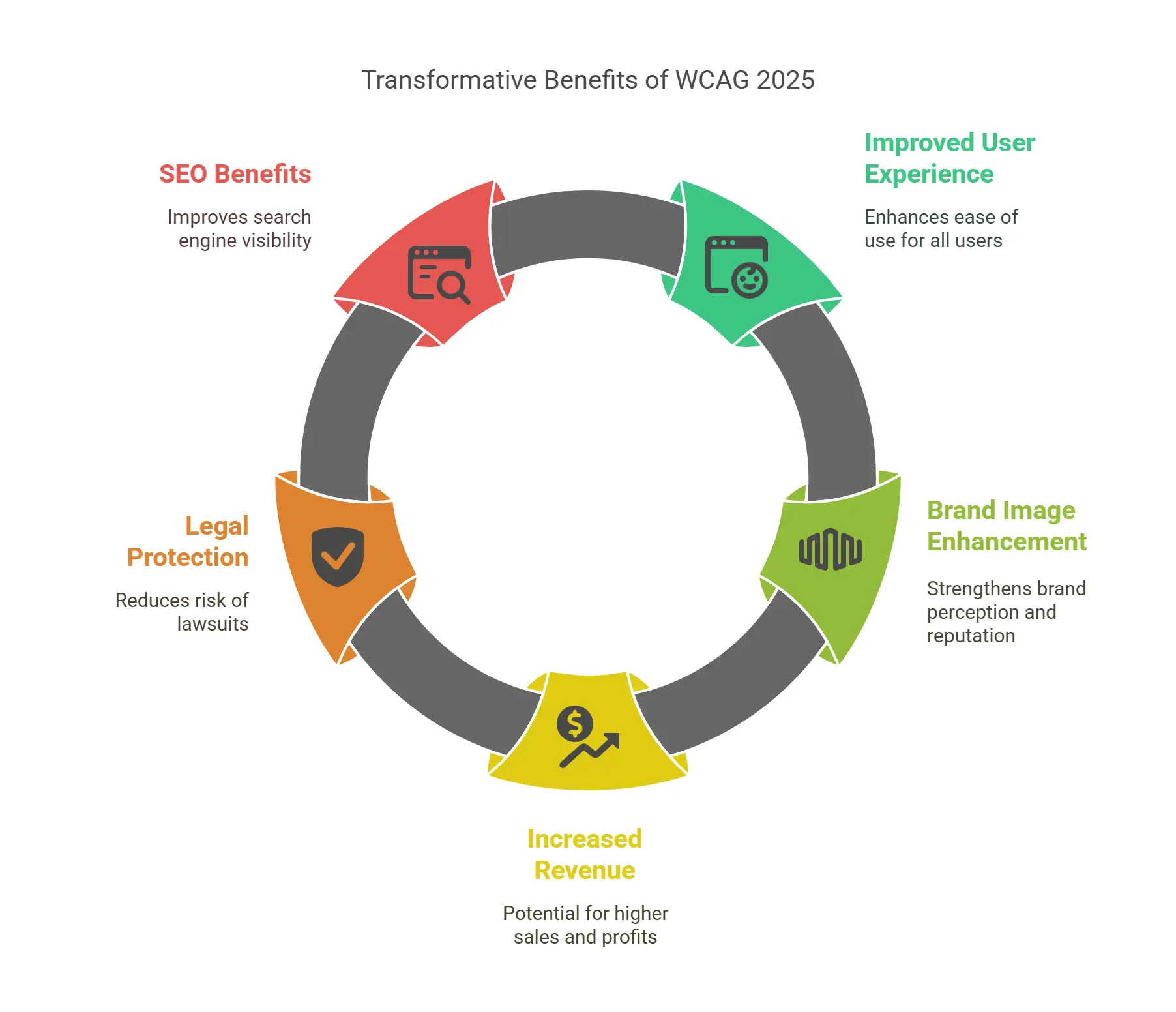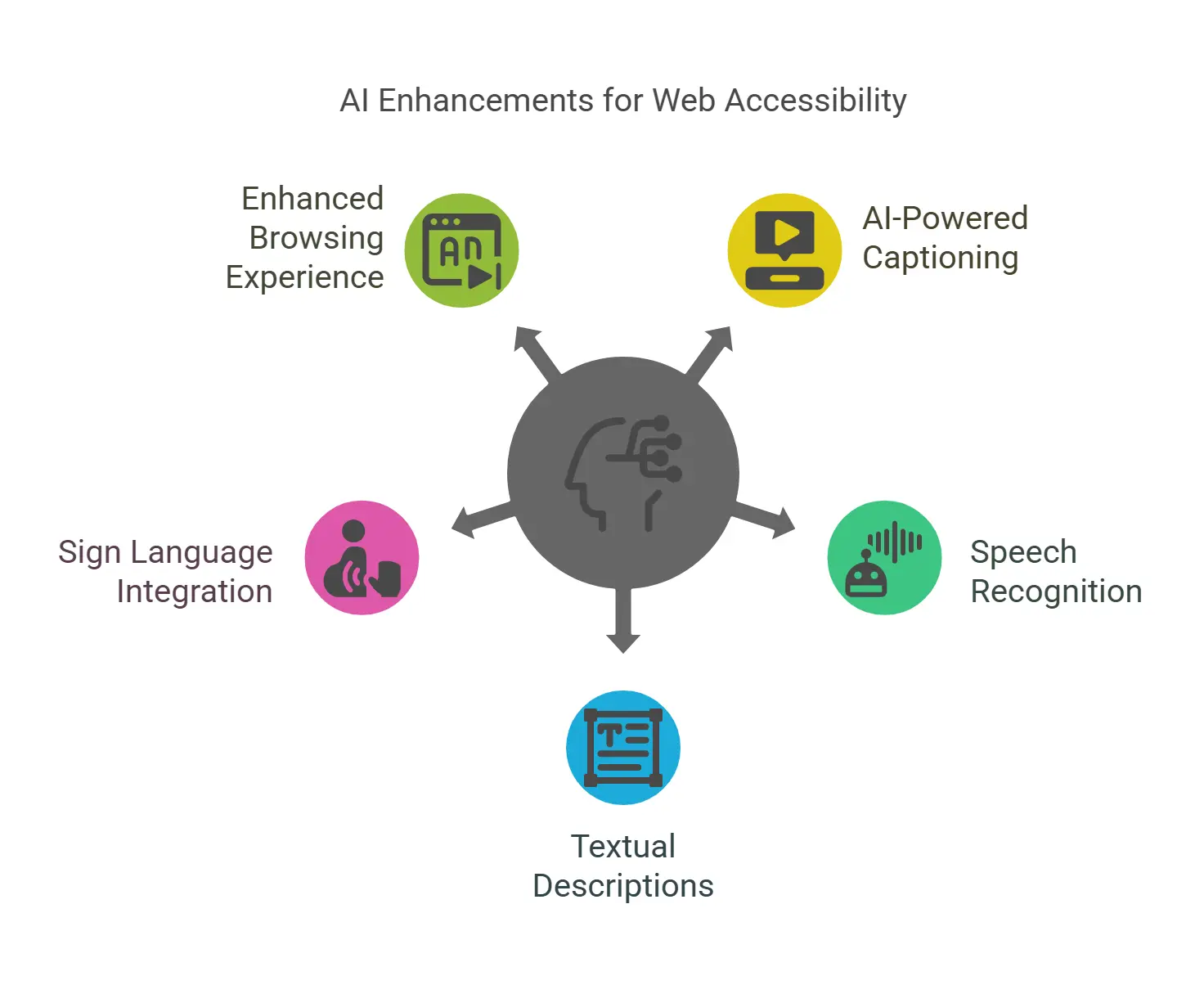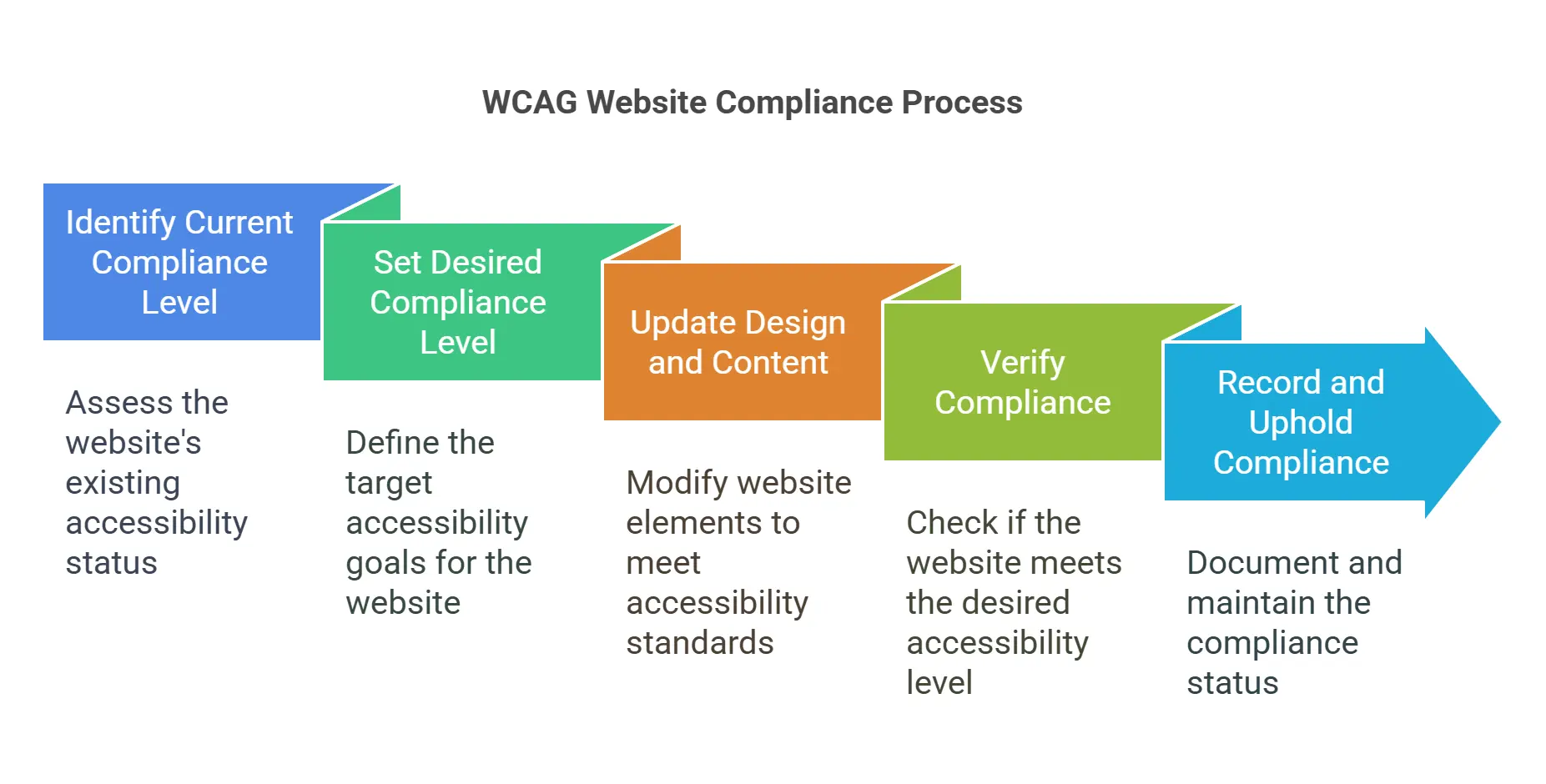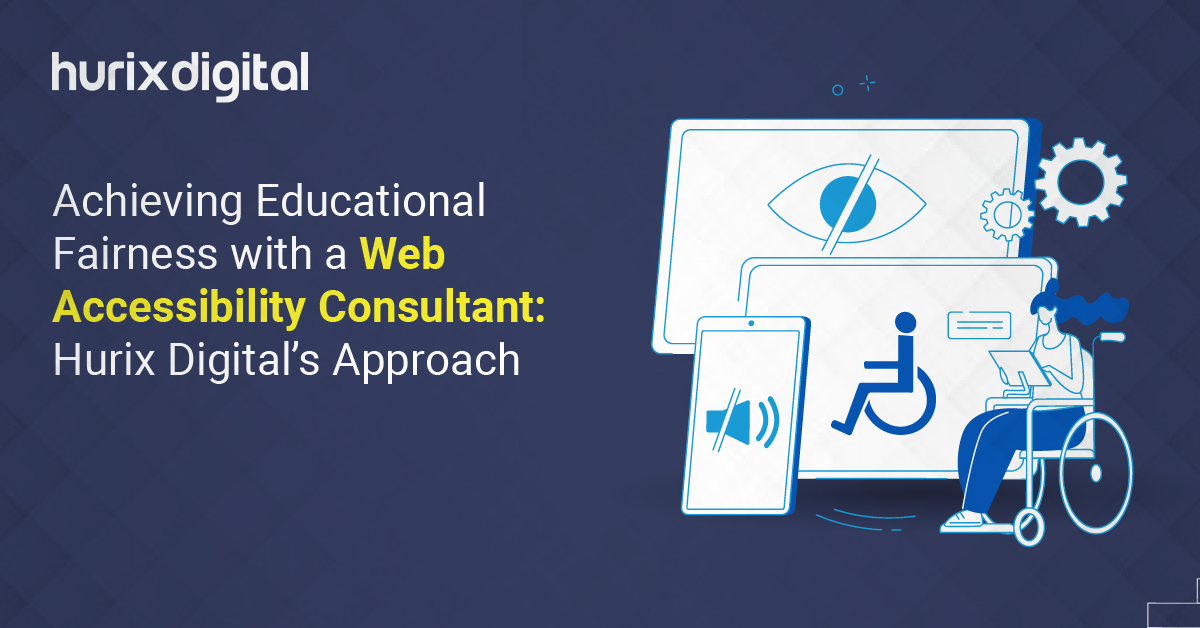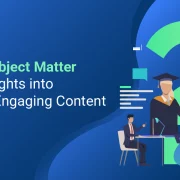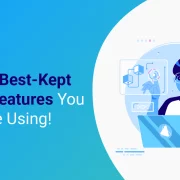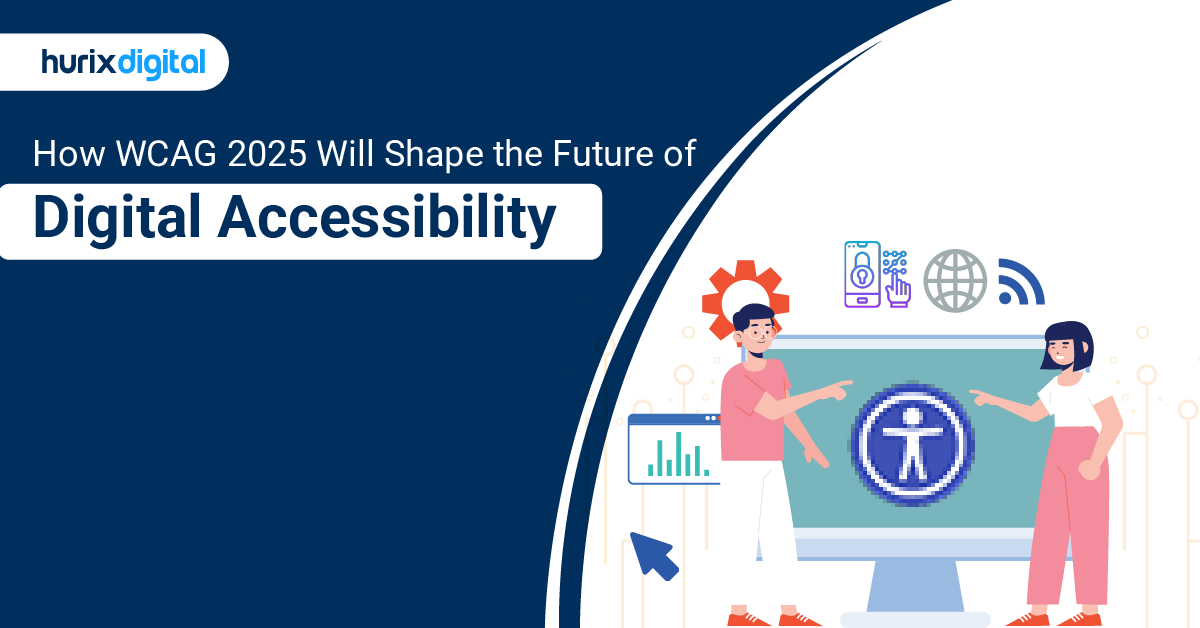
How WCAG 2025 Will Shape the Future of Digital Accessibility
Summary
WCAG guidelines, particularly 2.1 and upcoming 2.2, are essential for creating accessible online spaces. Compliance ensures inclusivity, legal adherence (EAA 2025), and broader market reach. AI aids accessibility but requires careful oversight. Businesses should prioritize WCAG 2025, using audits and expert guidance, for enhanced SEO and brand reputation.
In an era of digital connectivity, ensuring inclusivity in online spaces is more critical than ever. WCAG 2025 introduces an evolved framework to enhance digital accessibility, catering to users with diverse needs. By adhering to these updated Web Content Accessibility Guidelines, organizations can create digital experiences that are more equitable, user-friendly, and compliant with the latest accessibility standards.
Table of Contents:
- A Brief Introduction to WCAG and Its Core Principles
- What is the Relevance of WCAG?
- What You Should Know About the Latest WCAG 2.1 Guidelines?
- What is WCAG 2.2 Compliance?
- What’s New in WCAG 2.2?
- What are WCAG Compliance Levels: A, AA, and AAA?
- The European Accessibility Act (EAA) 2025
- EAA’s, WCAG 2.1 and their Impact on Educational Publishers
- How Can WCAG 2025 Transform Your Organization?
- 5 Benefits of WCAG Compliance for Your Business’s Online Presence
- The Role of Artificial Intelligence in Increasing Web Accessibility
- AI-Powered Accessibility Solutions: A Doubled-Edged Sword?
- Four Best Practices for WCAG Compliance
- How to Prepare Your Website for WCAG 2025?
- Step-by-Step Guide to WCAG Website Compliance
- Conclusion
A Brief Introduction to WCAG and Its Core Principles
The Web Content Accessibility Guidelines (WCAG), specifically its latest iteration, WCAG 2.1, constitute a comprehensive global framework that outlines accessibility standards for digital content that cater to individuals with diverse educational needs.
These guidelines serve as a universal reference for enhancing website accessibility. The European Accessibility Act (EAA) aligns itself with WCAG’s core principles, which revolve around four key aspects:
- Perceivability: Ensuring that information and user interface components are presented in ways that users can comprehend.
- Operability: Focusing on the usability of user interface components and navigation, making them functional and easily operable.
- Understandability: Emphasizing that information and the operation of the user interface must be clear and comprehensible to users.
- Robustness: Stipulating that content must be resilient enough to be reliably interpreted by a variety of user agents, including assistive technologies.
These fundamental principles, as defined by WCAG guidelines, are integral to the European Accessibility Act (EAA), as highlighted in the Act’s documentation on page 7.
Embracing these principles not only ensures compliance with the EAA but also contributes to a digital environment that is accessible and inclusive for users with diverse needs.
What is the Relevance of WCAG?
The digital realm thrives on user engagement, yet millions with disabilities face impenetrable walls on inaccessible websites. Ignoring WCAG is unfair not just for the users but for your organization as well. Non-compliance with WCAG locks out 16% of the global population, consisting of a vast consumer base and workforce.
Moreover, the European Accessibility Act mandates accessibility for all digital products and services by June 2025. Thus, digital accessibility is a win-win for users and businesses alike.
WCAG 2025 aims to create an all-inclusive digital future where everyone can access vital resources and the digital world lives up to its full potential. It ensures that no one is ignored in the click-and-swipe revolution. Website inaccessibility can cause businesses to face legal repercussions and miss out on a vast untapped market.
It is no longer a matter of good ethics but has become a legal and economic necessity. It helps build a loyal customer base, attract top talent, and foster a positive brand image that resonates with a larger audience.
What You Should Know About the Latest WCAG 2.1 Guidelines?
WCAG 2.1 is like an upgrade to WCAG 2.0. It adds new rules to make websites more accessible. These new rules include things like making sure websites work well when your device is turned in different directions, explaining the purpose of input fields, and improving how text looks.
If a website follows the new rules in WCAG 2.1, it automatically follows the old rules in WCAG 2.0. Here is a table summarizing the total accessibility features in WCAG 2.0, newly added features in WCAG 2.1, and their total.
| Levels | WCAG 2.0 | WCAG 2.1 | Total |
| A –Basic web accessibility features | 25 | 5 | 30 |
| AA –Biggest and most common barriers | 13 | 7 | 20 |
| AAA –The highest level of web accessibility | 23 | 5 | 28 |
| Total | 61 | 17 | 78 |
Even if the official requirements mention WCAG 2.0, it’s recommended that websites start following WCAG 2.1. This is because it makes websites more accessible and ready for future rule changes.
Here are some of the new rules in WCAG 2.1:
- Orientation (AA): Websites should work well when your device is turned on.
- Identify Input Purpose (AA): Explain the purpose of input fields.
- Identify Purpose (AAA): Clearly state the purpose of the content.
- Reflow (AA): Content should adjust when you change the size of your screen.
- Non-text Contrast (AA): Make sure non-text elements have enough contrast.
- Text Spacing (AA): Improve text spacing for better readability.
- Content on Hover or Focus (AA): Ensure that content appears and works correctly when you hover over or focus on it.
- Character Key Shortcuts (A): Allow users to use keyboard shortcuts.
- Timeouts (AAA): Give users enough time to interact with content.
- Animation from Interactions (AAA): Ensure animations don’t confuse.
- Pointer Gestures (A): Support touch gestures.
- Pointer Cancellation (A): Allow users to cancel actions with touch gestures.
- Label in Name (A): Make sure labels match the names of elements.
- Motion Actuation (A): Support motion-based interactions.
- Target Size (AAA): Ensure that interactive elements are large enough.
- Concurrent Input Mechanisms (AAA): Support multiple ways for users to interact.
- Status Messages (AA): Provide clear messages about the status of the website.
WCAG 2.1 follows the same rules as WCAG 2.0 but adds a couple more. This is explained in the part about following the rules (Conformance section).
The idea is that if a website follows the rules of WCAG 2.1, it automatically follows the rules of WCAG 2.0. WCAG compliance makes the website meet certain accessibility standards and helps make it better for people using the internet.
What is WCAG 2.2 Compliance?
WCAG 2.2, which stands for Web Content Accessibility Guidelines, version 2.2, is a set of rules that ensure your website is accessible to people with disabilities.
These rules are categorized into three levels of WCAG compliance levels: A (lowest), AA (midrange), and AAA (highest). To ensure that your website is aligned with these levels, using a WCAG accessibility checker might be helpful.
It systematically tests your site for WCAG website compliance, ensuring your digital space is inclusive and legally sound. The benefits of understanding the WCAG guidelines and a WCAG Accessibility Checker are countless, as summarized below:
- Familiarizing yourself with the WCAG guidelines and its various WCAG compliance levels is a key element in your journey to achieving compliance. This understanding of the fundamental rules forms the foundational step.
- Employing tools such as the WCAG Accessibility Checker not only streamlines the process but also ensures detailed attention, making certain nothing is missed.
Striving for WCAG compliance is not just for legal precautions; it also helps in expanding your business reach to more potential customers who might be living with a disability.
What’s New in WCAG 2.2?
WCAG 2.2 is set to build upon the foundation laid by its predecessors. WCAG 2.2 aims to make the web more user-friendly and inclusive for everyone by enhancing web accessibility. Here are some key highlights:
1. Guideline 2.4 Navigable
- Focus Not Obscured (Minimum) (AA): Ensure when an item gets keyboard focus, it is at least partially visible.
- Focus Not Obscured (Enhanced) (AAA): Ensure when an item gets keyboard focus, it is fully visible.
- Focus Appearance (AAA): Use a focus indicator of sufficient size and contrast.
2. Guideline 2.5 Input Modalities
- Dragging Movements (AA): Use a focus indicator of sufficient size and contrast.
- Target Size (Minimum) (AA): Ensure targets meet a minimum size or have sufficient spacing around them.
3. Guideline 3.2 Predictable
- Consistent Help (A): Put help in the same place when it is on multiple pages.
- Guideline 3.3 Input Assistance
- Redundant Entry (A): Don’t ask for the same information twice in the same session.
- Accessible Authentication (Minimum) (AA): Don’t make people solve, recall, or transcribe something to log in.
- Accessible Authentication (Enhanced) (AAA): Don’t make people recognize objects or user-supplied images and media to log in.
What are WCAG Compliance Levels: A, AA, and AAA?
The Web Content Accessibility Guidelines, commonly referred to as WCAG, serve the important function of improving web content accessibility for individuals dealing with different impairments. To accomplish this mission comprehensively, WCAG compliance levels A, AA, and AAA have been distinctly created.
- Level A acts as the fundamental tier of compliance, devised to ensure a basic degree of accessibility in web content. Websites that fail to meet these criteria often prove significantly challenging for individuals with disabilities to navigate and utilize.
- Level AA occupies the mid-range, encapsulating all the criteria of A-level with added stipulations. A significant number of businesses set AA-level compliance as their target, considering the ideal balance it offers between achieving accessibility and the effort required in its application.
- Level AAA holds the ranking of the uppermost level of WCAG compliance. Comprising all the guidelines encompassed in the A and AA levels, it further bolsters them with sophisticated protocols. Although reaching the AAA level might not be a practicable goal for every business, it is an objective worth aiming for.
The European Accessibility Act (EAA) 2025
The European Accessibility Act (EAA) was officially released on June 28, 2019, mandating that EU member states incorporate its directives into their national legislation by June 28, 2022. Within the subsequent three years, until June 28, 2025, the stipulations of the EAA must be fully implemented.
This legislative framework is expected to have implications for educational publishers, particularly concerning the adoption and adherence to the WCAG 2.1. Educational publishers will need to align their practices with the accessibility standards outlined in the EAA to ensure compliance with the regulatory requirements set forth by the European Union.
EAA’s, WCAG 2.1 and their Impact on Educational Publishers
Amidst the ongoing anticipation of the EAA’s implementation at the national level, educational publishers are poised for significant changes, particularly in adopting the latest WCAG 2.1. This impending transition is inevitable, as the EAA underscores the necessity for access to audiovisual content and e-book files that seamlessly accommodate users with disabilities and their assistive technologies.
The EAA’s directives emphasize the importance of ensuring that all products align with the accessibility standards delineated in Section I of Annex I (pages 31-33). These requirements mirror the principles outlined in the WCAG, making compliance with WCAG 2.1 an integral aspect of meeting the accessibility mandates outlined by the Directive.
As educational publishers navigate this changing prospect, prioritizing the implementation of WCAG 2025 is not only a proactive measure but a crucial step toward ensuring inclusivity and accessibility in the digital educational ecosystem.
How Can WCAG 2025 Transform Your Organization?
The lifeblood of any online organization is traffic. A steady stream of clicks and conversions fuels its growth and success. WCAG 2025 compliance can positively impact your business in several ways. Let us discuss them in detail.
1. Browsing Becomes a Breeze
Steer clear of digital roadblocks and step into a world of smooth browsing for everyone. Following website accessibility recommendations makes your webpage clearer, more intuitive, and easier to use for everyone. It facilitates customer satisfaction by improving user experience, which results in higher engagement, better conversions, and a huge customer base.
2. Builds Your Brand’s Image
Users are naturally drawn to brands that address the issues of the audience. 82% of consumers prefer brands that mirror their values.
By complying with WCAG, organizations can appeal to a wider audience by being accessible to the impaired and also showcasing the willingness to come to their aid. It is like inviting everyone to the party, not just the select few. WCAG 2025 complaint enables you to foster a positive brand image that resonates with the modern consumer and helps expand your existing customer base.
3. Blows Revenue off the Charts
Organizations can engage in smart business by embracing web accessibility. An inclusive website attracts a larger audience, which in turn boosts sales and fosters loyalty among customers.
WCAG 2025 leads to higher revenue as it increases conversion rates. The math is simple. When individuals can browse through your website with ease, they are more likely to become loyal customers.
Moreover, ignoring the needs of differently-abled individuals is ethically questionable and speaks volumes about an organization. A user-friendly and inclusive website lets you into an untapped market, which helps boost sales. It also leads to word-of-mouth promotion as satisfied customers become your biggest cheerleaders, sharing their positive experiences and drawing others in.
4. Keeps Lawsuits at Bay
In the digital era, ignoring web accessibility best practices is like entering a legal minefield with no escape plan. The awareness and legislation around digital inclusivity are rapidly increasing.
Failing to comply with WCAG 2025 in such a scenario can land your organization in a pickle. By ensuring that your website complies with accessibility standards, you can avoid costly legal battles and reputational damage.
Bringing accessibility to technology is the right thing to do and safeguards your business against potential lawsuits and fines. It is an investment in a future where inclusivity is not optional but a legal and ethical imperative.
5. Facilitates Search Engine Optimization
SEO optimization goes beyond mere chasing after elusive algorithms or mastering obscure tricks. It is about adopting and promoting inclusivity and building a digital space where everyone can thrive. Let us learn how WCAG 2025 is not just a checklist but a secret SEO:
- It encourages well-structured content, logical wayfinding, and descriptive text. These constitute a language that search engines understand and reward with higher rankings.
- Meaningful image descriptions boost relevance in image searches and ensure digital accessibility.
- Incorporating correct HTML tags for different content elements creates a clear hierarchy that search engines can grasp and make your website more relevant and discoverable.
- Accessibility tools in websites attract leads by providing a better browsing experience and lower bounce rates. All these lead to higher SEO rankings.
Thus, website accessibility is the foundation for SEO success as it enables businesses to create a digital space that search engines can easily navigate and rank.
5 Benefits of WCAG Compliance for Your Business’s Online Presence
Adherence to WCAG 2.2 compliance brings about significant advantages for your business, particularly in today’s digital age, where accessibility is pivotal.
Whether it’s about amplifying user interactions or boosting your company’s image, aligning with the updated standard levels of WCAG 2025 compliance isn’t just a matter of ethics – it’s a strategic move for your business. Here’s why:
1. Helps Increase User Interaction
Websites built with compliance with WCAG 2.2 are not only easy to navigate but are also user-friendly – a win-win for all users, including those with disabilities.
The WCAG accessibility checker is an instrumental tool for identifying issues that might negatively impact the user experience, hence optimizing your website.
2. Increased Digital Penetration
By adopting measures to enhance WCAG website compliance, a company can dramatically broaden its digital reach, effectively tapping into an audience group that was previously unreachable. In essence, improved accessibility elaborates the narratives of a company’s online visibility and brand recognition.
Worth noting, according to a report by the World Bank, globally, 1 billion people, constituting 15% of the world’s population, experience some form of disability. Catering to this significant demographic can have a huge, positive impact on a business.
3. Optimizing SEO Strategies
Adherence to WCAG compliance mutually benefits your website’s accessibility endeavors and search engine optimization strategies. Thus, integrating WCAG 2.2 compliance can significantly contribute to optimizing your SEO strategies.
4. Regulatory Adherence
Compliance with the WCAG 2.2 is not merely a choice for businesses but a mandate enforced by several regulatory authorities worldwide. Failing to meet the WCAG compliance levels can lead to penalties and legal issues.
Undertaking a preliminary WCAG audit and recurrent WCAG testing can act as a protective shield, preventing your business from facing potential fiscal setbacks and brand image impairment.
5. Fortify Brand’s Reputation
Staying current with WCAG website compliance not only underscores your commitment to accessibility but also serves as a compelling testament to your dedication toward inclusion. By ensuring all users have unrestricted access to information and services, such a stance can substantially enhance your brand’s reputation and loyalty factor.
The Role of Artificial Intelligence in Increasing Web Accessibility
The digital world is ever-evolving. Ensuring equal access to everyone becomes a matter of supreme importance in such a scenario. Websites must adhere to WCAG to create inclusive experiences for individuals with disabilities.
However, achieving seamless accessibility can be a complex and continuous process. Artificial Intelligence emerges as a powerful ally that helps streamline efforts and enhances digital accessibility features with remarkable precision.
Let us discuss the impact of AI in increasing website accessibility.
1. AI-Powered Captioning to Bridge the Auditory Gap
One of the most incredible applications of AI lies in multimedia content captioning. Videos, podcasts, and online presentations often leave people with hearing impairments at a disadvantage.
But with the emergence of AI tools, one can automatically generate accurate and synchronized captions, translating spoken words into text that appears alongside the audio. This allows individuals with hearing difficulties to engage with the content fully.
2. Speech Recognition to Empower Hands-Free Navigation
Traditional keyboard and mouse controls can pose significant challenges for individuals with physical disabilities or limited mobility. AI-powered speech recognition technology can help these users surf websites and interact with content solely through voice commands.
With the integration of chatbots or virtual assistants, websites can leverage the power of speech recognition to guide users, answer questions, and assist. This offers a convenient and intuitive browsing experience for everyone.
3. Facilitate Visual Understanding with Words
Images and graphics are central to the web, but for people with visual impairments, they can remain cryptic and inaccessible. AI-powered object detection and image recognition help analyze visual content and translate it into descriptive text or audio.
Screen readers’ narration becomes the eyes of visually impaired individuals, providing them with a clearer understanding of the page’s visual context.
4. Include Sign Language
Sign language is the primary mode of communication for the deaf and mute. AI-powered Sign Language translation technologies can automatically translate text content into video interpretations in Sign Languages, such as American Sign Language (ASL).
This feature allows individuals to consume information readily available to hearing users despite their disabilities.
5. Enhance the Browsing Experience
AI-based analytics identify accessibility barriers within a website’s layout and suggest improvements to optimize the user’s overall experience. AI can personalize website interfaces and content based on individual needs and preferences to enhance accessibility for users with varied disabilities further.
AI-Powered Accessibility Solutions: A Doubled-Edged Sword?
While AI holds immense promise for boosting website accessibility, its limitations can construct barriers for users with disabilities.
For instance, the text-to-speech feature is impressive but can stumble over complex pronunciations or nuance, leaving visually impaired users with a garbled picture of the written content. Similarly, voice recognition also falters at times and misinterprets accents, stutters, or background noise, rendering interaction a laborious exercise in frustration.
Automatic video captioning also falls short at times. Misidentified words, incorrect punctuation, and faulty descriptions can confuse differently-abled viewers. Imagine relying on captions to understand a medical video only to encounter nonsensical terms, making the consequences of inaccurate AI assistance severe.
While AI has the potential to break down barriers, its reliance on algorithms leaves it vulnerable to errors that can exacerbate existing limitations for disabled users. Differently-abled users face accessibility errors in 4.8% of home page elements.
Responsible development, prioritizing human oversight, and rigorous testing can ensure that AI tools are accurately bridging the gap, not widening it.
Four Best Practices for WCAG Compliance
There are innumerable ways to make your website and digital offerings welcoming and usable for everyone. Acquaint yourself with the best practices of WCAG below.
- Have accessibility specialists assess your digital platform and offer solutions that work for everyone.
- Train your employees on accessibility best practices to foster a culture of compliance.
- Implement the audit findings and act upon the experts’ suggestions.
- Improvise. Adapt. Evolve. Keep abreast of advancements in the field and stay on top of your web accessibility game.
How to Prepare Your Website for WCAG 2025?
Here’s how you can prepare your website for WCAG 2025:
- Enlist web accessibility experts to audit your website and apps to suggest inclusive solutions.
- Train your employees on accessibility guidelines. Knowing the rules creates a culture of ongoing compliance and a commitment to universal reach.
- Take action on the audit findings. Add alt text to images, insert video captions, and ensure your platforms are keyboard-friendly.
- Do not be static. Adapt your platform proactively as technology and guidelines evolve.
Step-by-Step Guide to WCAG Website Compliance
Moving towards WCAG 2.2 compliance may seem challenging, but by leveraging the comprehensive strategy outlined below, your business can achieve seamless conformity with WCAG compliance levels.
This journey not only enhances your website’s accessibility but also augments its user experience, elevating your brand’s credibility in the marketplace.
1. Identifying your Current WCAG Compliance Level
The primary step towards attaining WCAG website compliance is pinpointing your present position. For this preliminary audit, use a credible WCAG accessibility checker.
Familiarize yourself with aspects of accessibility where your site thrives and where it needs improvements. This insight will facilitate the crafting of a strategic plan for enhancement.
2. Set your Desired WCAG Compliance Level
Considering your business objectives and target demographics, establish the compliance level you aspire to accomplish.
The three prominent WCAG compliance levels are A, AA, and AAA, with AAA being the most rigorous. A majority of businesses aim for level AA as it offers a healthy equilibrium between affordability and compliance.
3. Update your Website Design and Content
Having decided your target compliance level, the subsequent step is to revamp your website design and content to meet the chosen criteria.
This phase can be labor-intensive, encompassing text modifications, color contrast amendments, navigation adjustments, and more. Nevertheless, it is imperative for achieving WCAG compliance.
4. Verify for Compliance
Following requisite changes, employ the WCAG accessibility checker yet again to examine whether your site complies with the standards now. Undertake WCAG testing on a variety of devices and browsers to guarantee a thorough compliance verification.
5. Record and Uphold your Compliance Status
Upon accomplishing the desired compliance standard, it is essential to sustain it. Regular WCAG audits ensure that you maintain compliance as your website progresses. Document all measures taken for maintaining transparency and as a record for displaying your compliance to stakeholders or legislative bodies.
One—It’s crucial to understand that achieving WCAG compliance isn’t a one-time affair; instead, it’s an ongoing process. As your website continuously evolves, the accessibility requirements will also adapt and evolve.
By conducting consistent testing and updates, your business ensures it remains in line with these fluctuating standards. This commitment not only guarantees a smooth, user-friendly experience but also ensures inclusivity for all your site visitors.
Conclusion
While WCAG is a tool in the hands of businesses, understanding its intricacies can be a challenging task.
Remember, accessibility is not just a checklist; it’s a commitment to ensuring digital spaces are welcoming to everyone. By embracing the principles of WCAG, your organization not only complies with regulations but also fosters a culture of empathy and inclusion.
Understanding the intricacies of WCAG 2025 might seem daunting for businesses, but the rewards are undeniable. Leveraging AI for web accessibility has multifaceted benefits. Not only does it empower individuals with disabilities, but it also improves everyone’s overall user experience.
Websites adhering to WCAG guidelines enjoy better search engine rankings, as Google prioritizes accessible content. Moreover, creating an inclusive online environment fosters diversity and social responsibility, building a more equitable digital landscape for all.
Inclusivity is not an option but necessary to gain a competitive edge and build an all-inclusive brand. Preparing for WCAG implementation requires investment, but the long-term benefits outweigh the initial costs. Choose Hurix Digital for WCAG with its AI-powered accessibility solutions.
While WCAG 2025 provides the roadmap to achieve accessibility, Hurix Digital tackles the challenges head-on by offering comprehensive accessibility testing, expert remediation, and continuous follow-up under one roof.

Vice President – Digital Content Transformation. He is PMP, CSM, and CPACC certified and has 20+ years of experience in Project Management, Delivery Management, and managing the Offshore Development Centre (ODC).

